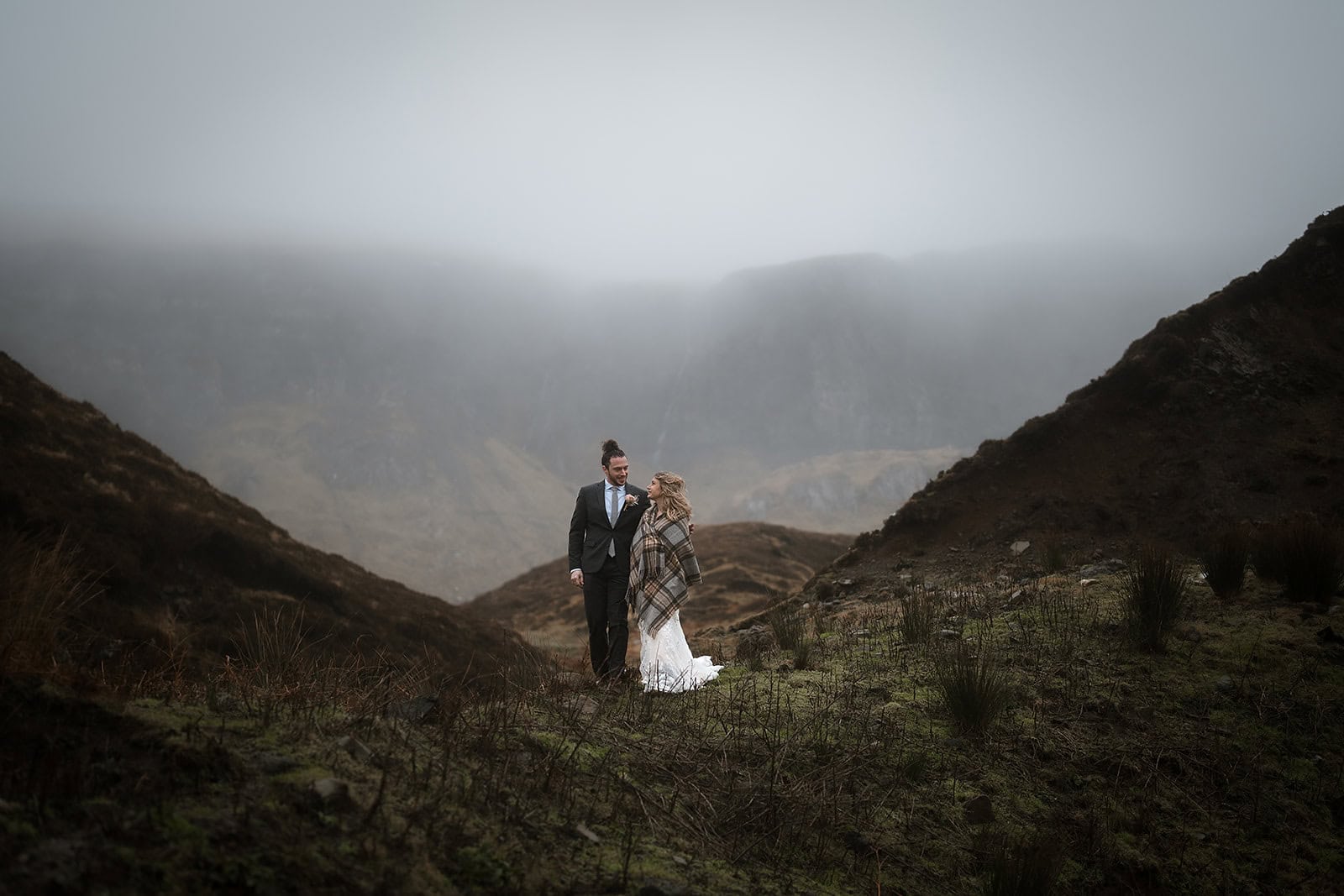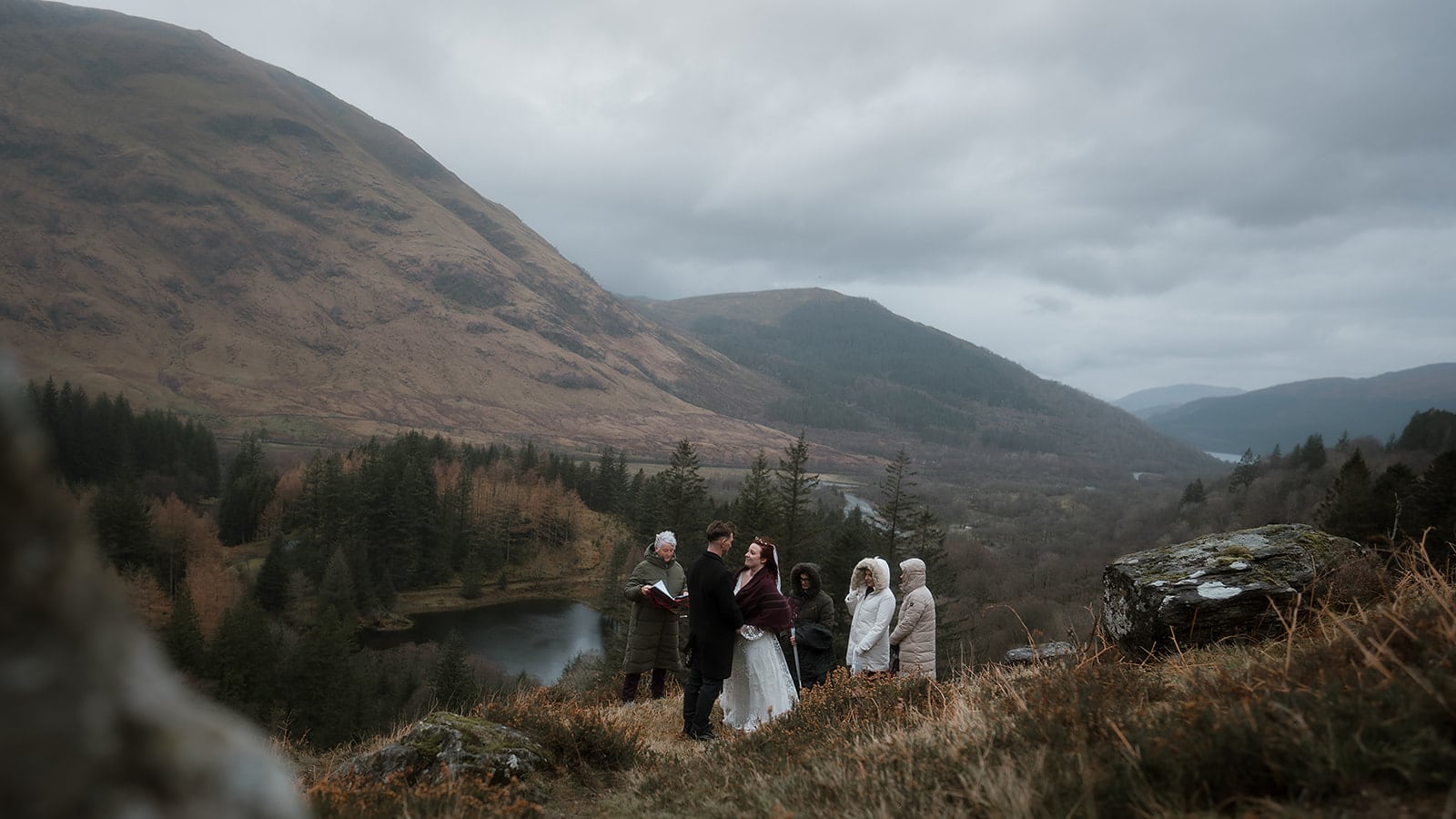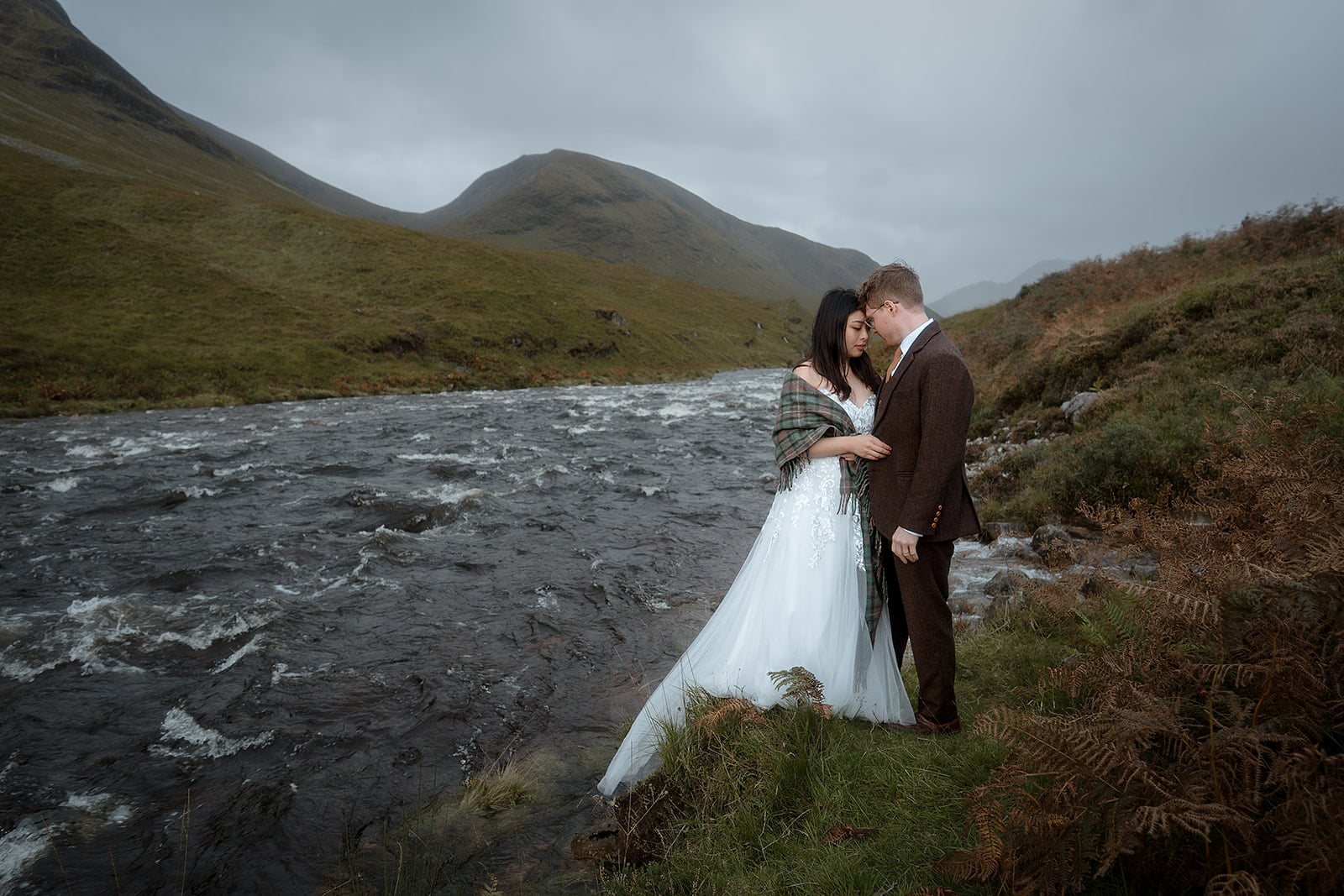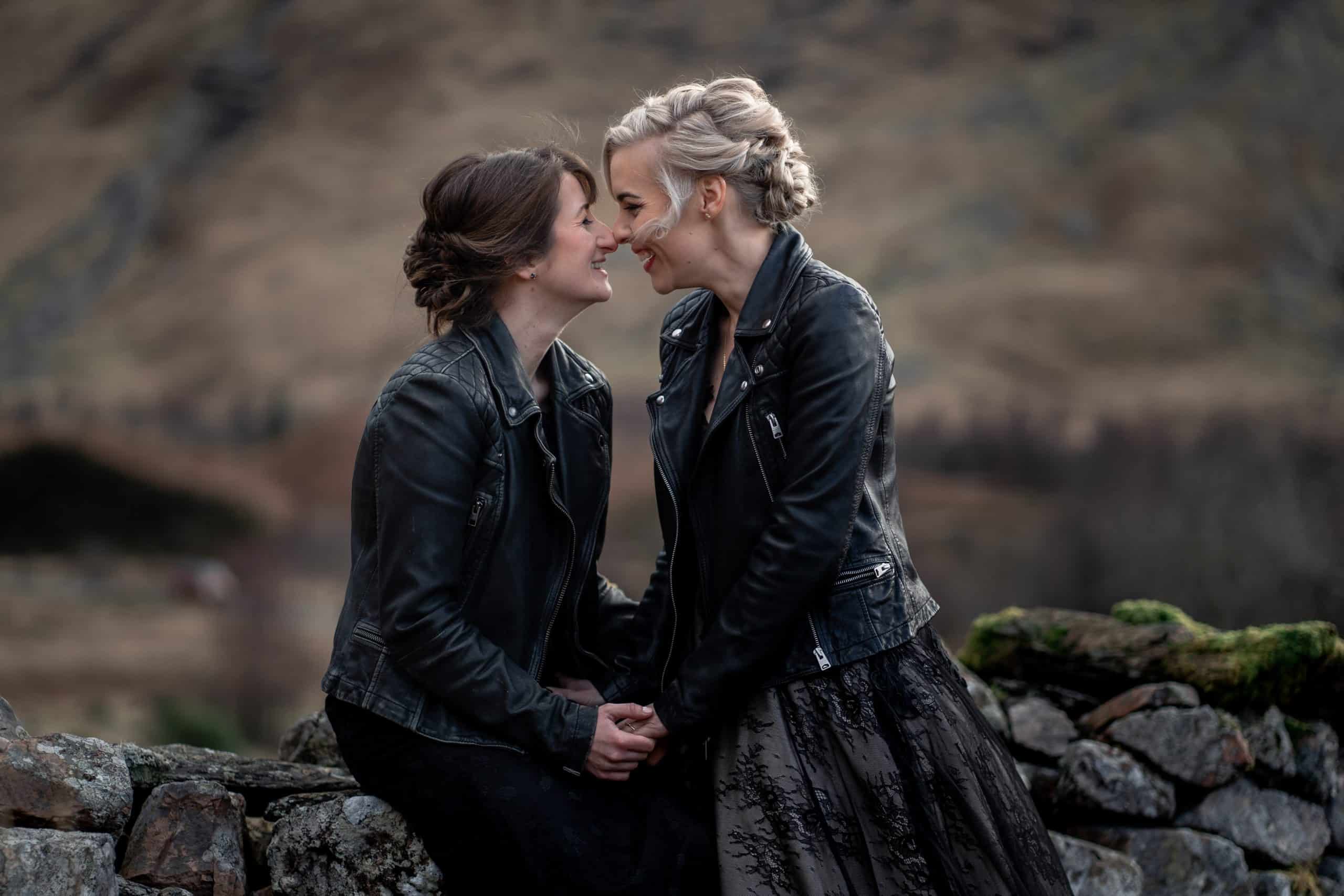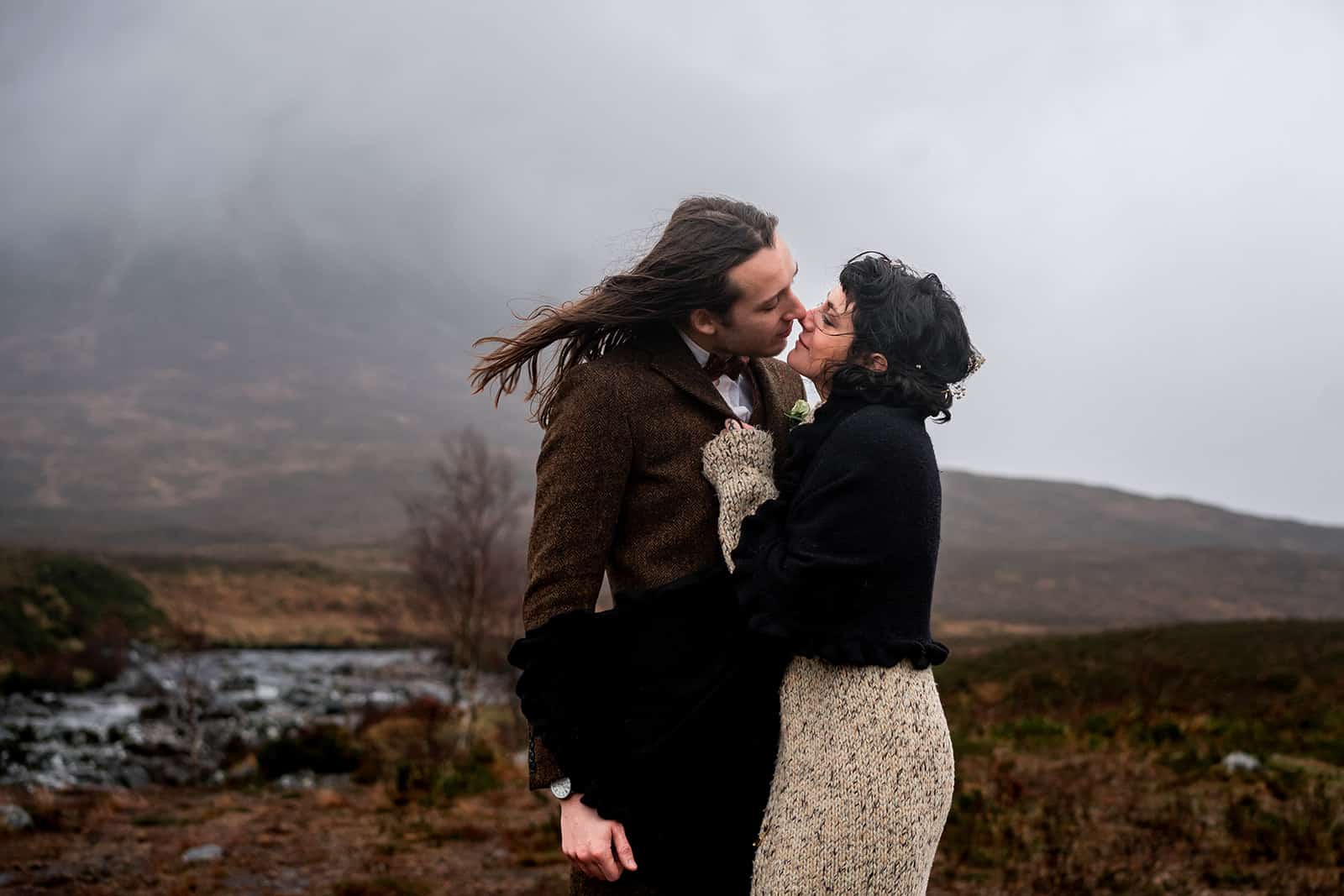wedding traditions for your elopement in scotland
Many of our clients try to involve one or more Scottish wedding traditions in their elopement ceremony. These traditions are steeped in history and rich cultural heritage. The Highland and Gaelic cultures have their own unique set of customs and traditions, some of which have been passed down through generations. Here are a few of the most notable ones with a possible explanation to their beginnings.
Handfasting
Hand-fasting is an ancient Celtic and Medieval custom, especially common in Scotland, in which two people came together at the start of their marriage relationship to declare of their own free will that they intended to marry.
While facing each other, the couple will join hands while a cloth is tied around their hands in a knot. This is where the term “tie the knot” came from. Couples often choose to use a cloth made of a particular clan tartan or a specific colour of cloth symbolising something important to them.
It often said that one lady from each side of the unit. would provide a torn piece of cloth from the bottom of her dress for the hand fasting. This cloth was left frayed as it was said that this symbolised that marriages would often need work and repair.
Quaich
The Quaich, a two handled loving cup, is an ancient Scottish tradition that seals the bond of two people, and marks the blending of two families. It symbolizes the love and trust implied by the bond, as the new couple shares the first drink of their marriage together.
As seen in Outlander, it was traditionally used by clansmen to pledge fealty to their clan/clan chief.
Many couples choose to both pour in a different drink – often a favourite whisky – so the liquids mix and symbolise the unity of marriage.
Handfasting
Hand-fasting is an ancient Celtic and Medieval custom, especially common in Scotland, in which two people came together at the start of their marriage relationship to declare of their own free will that they intended to marry.
While facing each other, the couple will join hands while a cloth is tied around their hands in a knot. This is where the term “tie the knot” came from. Couples often choose to use a cloth made of a particular clan tartan or a specific colour of cloth symbolising something important to them.
It often said that one lady from each side of the unit. would provide a torn piece of cloth from the bottom of her dress for the hand fasting. This cloth was left frayed as it was said that this symbolised that marriages would often need work and repair.
Quaich
The Quaich, a two handled loving cup, is an ancient Scottish tradition that seals the bond of two people, and marks the blending of two families. It symbolizes the love and trust implied by the bond, as the new couple shares the first drink of their marriage together.
As seen in Outlander, it was traditionally used by clansmen to pledge fealty to their clan/clan chief.
Many couples choose to both pour in a different drink – often a favourite whisky – so the liquids mix and symbolise the unity of marriage.

Oathing Stone
This is a traditional Scottish custom where the bride and groom take their vows on a flat stone. The Oathing Stone is said to symbolize the stability of the couple’s relationship and the strength of their commitment to each other.
The stone also symbolises the couples tie to the land. It is thought that hundreds of years ago that same stone may have witnessed the oaths of another couple or perhaps in hundreds of years time another couple may choose your stone.
Many couples will go for a walk in the morning to choose a special stone from a nearby forest or loch.
This is a traditional Scottish custom where the bride and groom take their vows on a flat stone. The Oathing Stone is said to symbolize the stability of the couple’s relationship and the strength of their commitment to each other.
The stone also symbolises the couples tie to the land. It is thought that hundreds of years ago that same stone may have witnessed the oaths of another couple or perhaps in hundreds of years time another couple may choose your stone.
Many couples will go for a walk in the morning to choose a special stone from a nearby forest or loch.

Jumping the Broom
In Highland culture and Celtic culture in general (as well as many other cultures across Europe and Africa) newlyweds participated in broom jumping at the end of the ceremony. The Highland tradition, in which a broom would sweep any dirt in front of the couple, who in turn would jump over the broom – representing getting rid of any bad omens. Some say that the broom was often put at the Threshold of the newlyweds house and the groom would carry the bride across.
Our couples who perform this tradition generally just lay a broom on the ground and step, rather than jump, over it. It always makes for a good photo however.
The Piper’s Toast
If you are having a piper at your elopement ceremony then consider the piper’s toast. After you have been piped to your ceremony location your piper will take a drink of whisky – often from a Quaich – after toasting the happy couple. These days the pipers will usually drink a soft drink especially if they have to drive home!
Blackening the Bride
Maybe one that you won’t do but still interesting…
Blackening is a traditional wedding custom performed in the days or weeks prior to marriages in rural areas of Scotland such as the Highlands and Islands. The bride is “captured” by friends and family, covered in food, or a variety of other – preferably adhesive – substances, then paraded publicly for the community to see. It is thought that the blackening has evolved from an earlier Scottish ritual called the feet-washing. You can find out more about this ritual here.
A Burns Poem Reading
Robert, or more commonly, Rabbie Burns was an 18th Century Scots Poet and is known as the National Poet of Scotland. His poems were written in the traditional Scots dialect and sounds familiar and yet unintelligible to most English language speakers.
Traditionally, his love poem “My love is like a red, red rose” is read during the ceremony but other poems can also be used.
And there you have it! 8 Scottish Traditions for your Scotland Elopement.
If you are in need of a Scotland Elopement Photographer, we would love to help you out! Get in touch today for availability.
In Highland culture and Celtic culture in general (as well as many other cultures across Europe and Africa) newlyweds participated in broom jumping at the end of the ceremony. The Highland tradition, in which a broom would sweep any dirt in front of the couple, who in turn would jump over the broom – representing getting rid of any bad omens. Some say that the broom was often put at the Threshold of the newlyweds house and the groom would carry the bride across.
Our couples who perform this tradition generally just lay a broom on the ground and step, rather than jump, over it. It always makes for a good photo however.
The Piper’s Toast
If you are having a piper at your elopement ceremony then consider the piper’s toast. After you have been piped to your ceremony location your piper will take a drink of whisky – often from a Quaich – after toasting the happy couple. These days the pipers will usually drink a soft drink especially if they have to drive home!
Blackening the Bride
Maybe one that you won’t do but still interesting…
Blackening is a traditional wedding custom performed in the days or weeks prior to marriages in rural areas of Scotland such as the Highlands and Islands. The bride is “captured” by friends and family, covered in food, or a variety of other – preferably adhesive – substances, then paraded publicly for the community to see. It is thought that the blackening has evolved from an earlier Scottish ritual called the feet-washing. You can find out more about this ritual here.
A Burns Poem Reading
Robert, or more commonly, Rabbie Burns was an 18th Century Scots Poet and is known as the National Poet of Scotland. His poems were written in the traditional Scots dialect and sounds familiar and yet unintelligible to most English language speakers.
Traditionally, his love poem “My love is like a red, red rose” is read during the ceremony but other poems can also be used.
And there you have it! 8 Scottish Traditions for your Scotland Elopement.
If you are in need of a Scotland Elopement Photographer, we would love to help you out! Get in touch today for availability.
